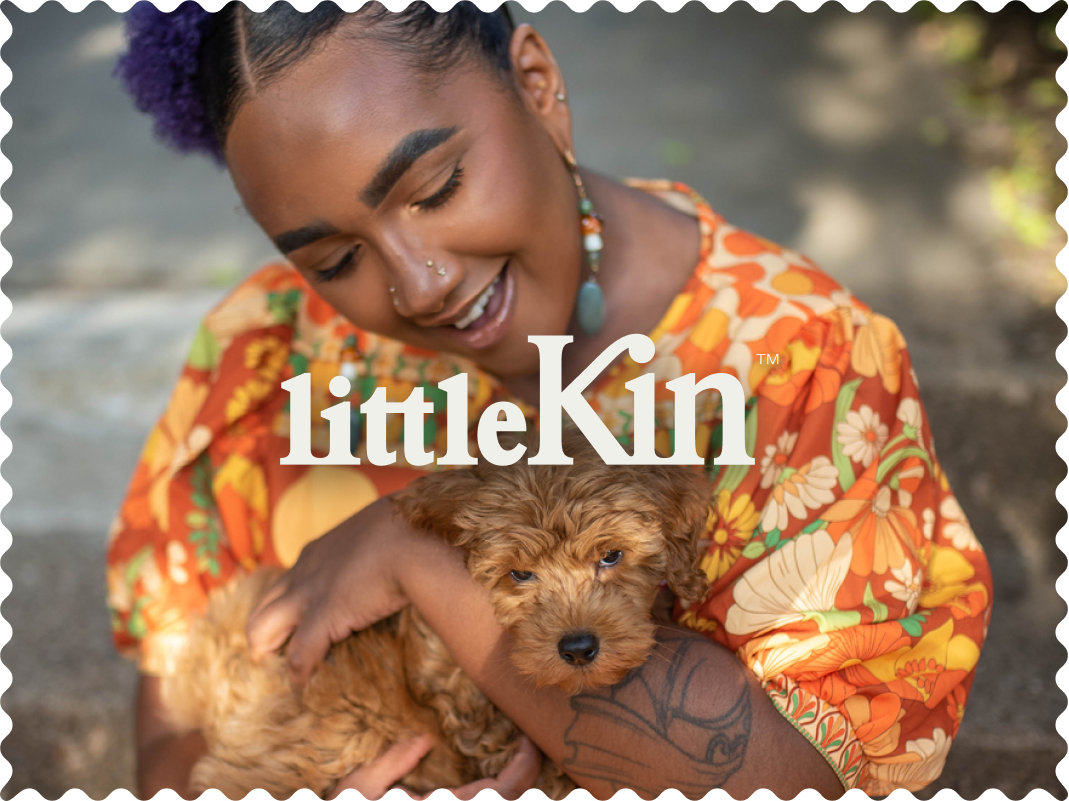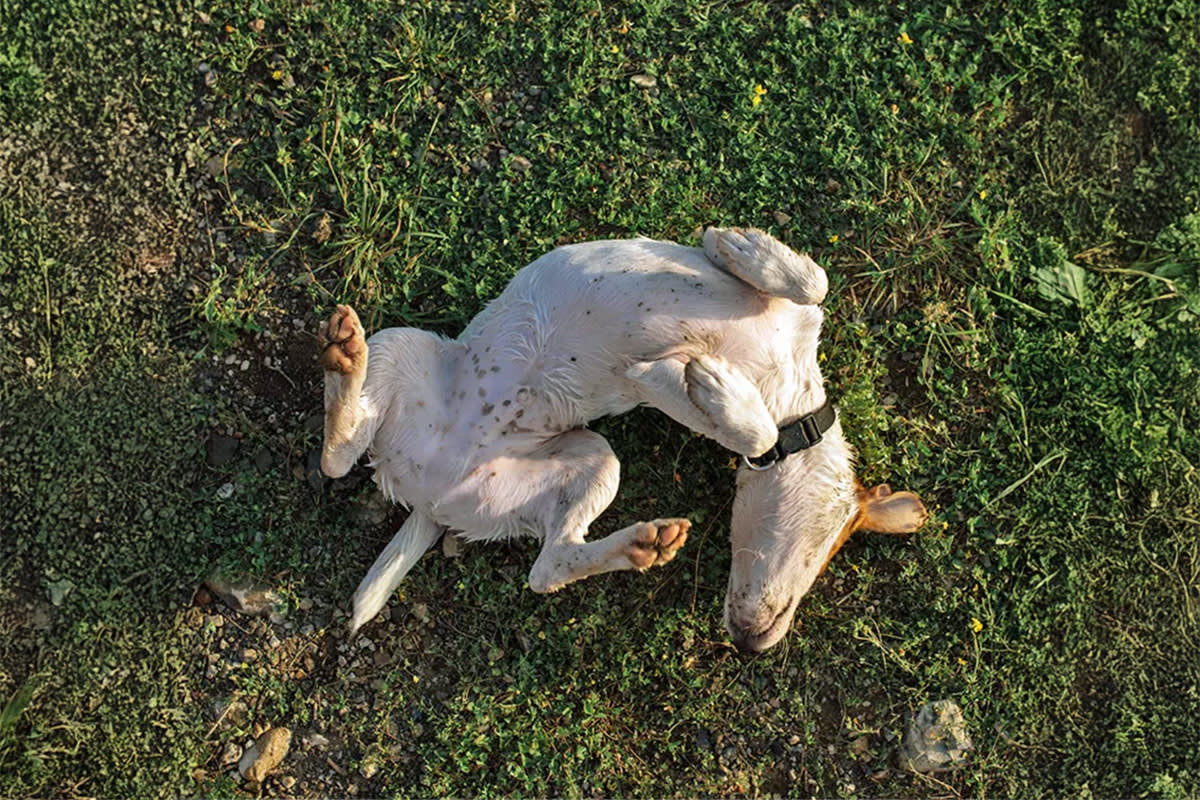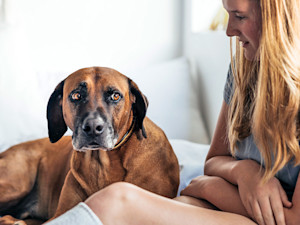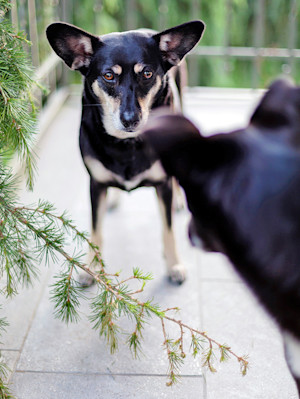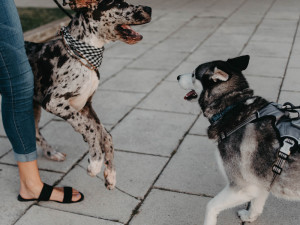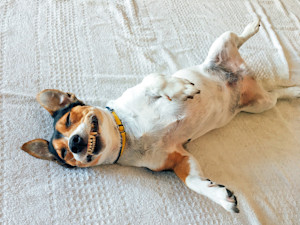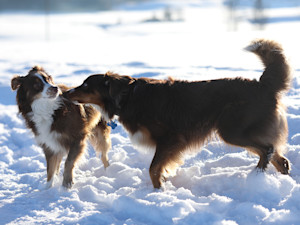8 Dog Playtime Myths—Busted
Chasing equals bullying, rolling over equals submission, and more untruths debunked here.
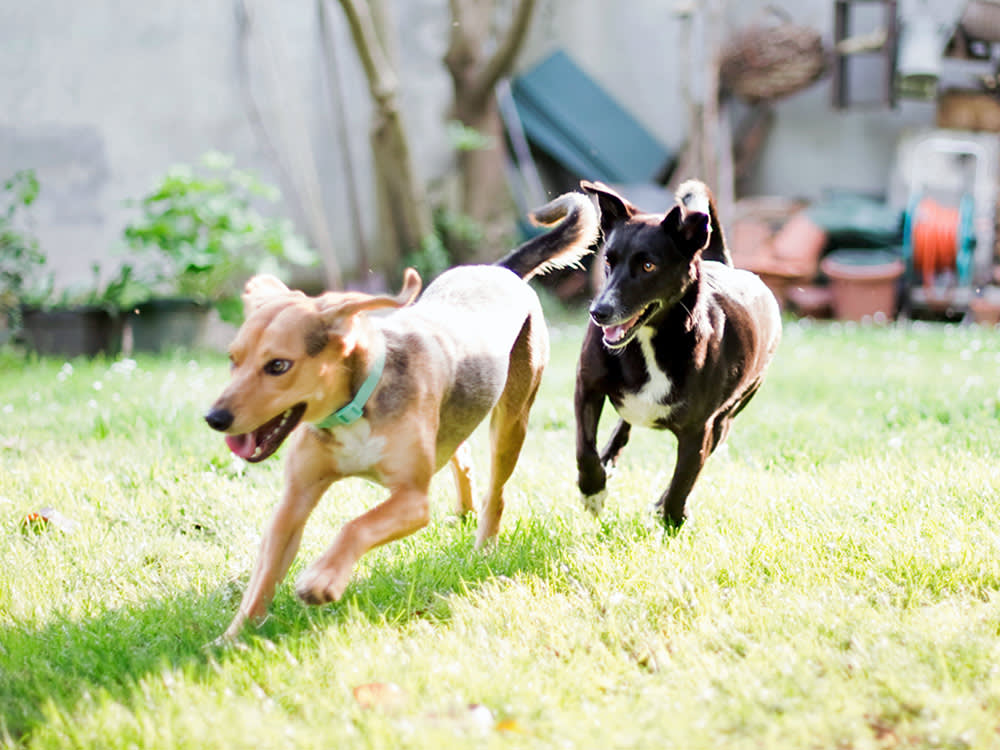
Share Article
Nothing is quite like watching a couple dogs go wild in a flurry of zoomies, pounces, and happy leaping — it’s pure joy... until it’s not. Play between dogs can leave us scratching our heads, and it’s easy to misread what’s really going on.
The good news? The more we understand their body language, the better we are at knowing when our dogs are having a good time and when they need a break. Let’s dig into some of the most common myths (often spread among pet parents) about dogs at play and set the record straight.
If they play rough, this will lead to a fight.
Play styles range in roughness. There’s no-contact chasing. Then there’s wrestling, which can range from calmly rolling around together to truly rough-and-tumble. An even rougher sort of play involves body slams (aka hurling themselves into the sides of their playmates with either their hips or shoulders).
Some dogs enjoy the rough-and-tumble stuff. If they are with another dog who likes a similar style of play, they are likely to be compatible, happily continuing on and on without a problem. Some observers may believe that it’s inevitable for a fight to break out, but that doesn’t mean it will.

The kind of play that can evolve into trouble is the kind that is upsetting to one or more of the dogs. That often happens when a dog doesn’t understand play or have much experience with it. It has less to do with how rough the action is and more to do with everyone being on board with the type of play and its intensity. Generally, all is well if everyone is having a good time, even if things get a little rough-and-tumble.
It’s always bad if a dog doesn’t show play signals.
Play signals (like a play bow, shown above) are how dogs tell others they want to play and how they invite others to do the same. These signals communicate the idea that their intentions are playful. It’s important for dogs to communicate they want to play so there’s no confusion, and nobody thinks they’re being attacked. Skipping play signals can lead to misunderstandings and a defensive response. If one dog starts to chase another dog, wrestle with them, or pounce on them, and the dog on the receiving end doesn’t realize the behavior is meant to be playful, they may react in a defensive way.
But sometimes, close dog friends who play together a lot, especially those in the same household, don’t bother with signals. Their relationship is so playful that there’s no confusion. In that case, every dog in the group assumes leaping, pouncing, chasing, and wrestling behavior is about play, so there is no need to clarify.
Growling is a bad sign during play.
Context is everything. Just as growling can be a warning between dogs (That’s my special chew toy!), if you say “I’m going to get you!” that can also be a warning to your dog, but both are also used playfully. Growling is common in play and is usually a sign that the dogs are really into their game.
The arousal that accompanies fun often leads to growling that is totally normal. A deepening intensity and slower, lower-pitched growls can indicate that things may get out of hand or at least that the dogs are starting to get more serious and a little less playful.
When this happens, it might be time for a break. You can use high-value treats to get both dogs to come to you to cool off. They may need to do so in separate spaces from each other; this way, everyone can take the time to calm down.
If one dog is consistently chasing the other, it’s bullying.
Not necessarily. Switching roles is great and often indicates wonderful play, but it’s not a requirement. It has become an absolute in too many people’s minds that dogs must trade off when playing chase to show good sportsmanship of sorts, but plenty of glorious play doesn’t involve switching.
For some dogs who play together, they each have their role — the chaser and the chase — and both dogs are perfectly happy about the situation. What’s not OK is when one dog is relentlessly chasing the other, and the one being chased is desperately trying to escape. In that case, the game needs to be put to a stop, and everyone needs a break.
Dogs of really different sizes can’t play together.
It’s not unusual to see dogs of different sizes playing together where both are having a great time. It often requires the bigger dog to adjust and adapt to keep it safe and fun, but it’s not uncommon to see a small dog and a big dog who are buddies. But while interacting with a small dog, the bigger dog can’t act like a freight train, plowing into or stepping on the little dog. So, a dog who is incapable of realizing that may need to stick to playing with dogs who are more similar in size.
Many big dogs, though, carefully watch where their feet are in relation to a little dog. Some will lie down or roll over on their back to play while the small dog leaps around their paws and head. Supervision is a good idea in all play, but it‘s especially necessary when the pups have a huge size difference — just in case the big dog is not being as gentle as necessary.
Not every big dog and little dog are a match, but when such opposites find a way to work it out, it’s super adorable. And if a stick or toy is involved, like in the photo above, keep an extra close eye on the pups to make sure everyone is staying safe.
All dogs like playing with other dogs.
Au contraire. There are dogs who live for their play time with other dogs, dogs who would be happy if every other dog on the planet disappeared, and everything in between. Some dogs are social butterflies who act as though every dog they see is their new best friend. Others are a bit cliquey, only interested in interacting with the few dogs they consider a part of their social group. It is often beneficial to introduce dogs to potential play buddies to see if they hit it off, but that’s not true for every dog.
For those dogs who are highly aggressive with other dogs, or just plain terrified of them, it’s totally fine if their social circle only includes humans. Although some dogs absolutely adore playing with other dogs, there are others who have no interest, and that’s OK, too.
A dog who rolls over on their back during play is being submissive.
In certain contexts, a dog will roll on their back in a gesture of appeasement, but play is not where that tends to happen. During play, formalities of social interactions are not front and center — everyone is just there to have a good time.
In order to get the fun going and to keep it going, many dogs will roll on their backs. Some dogs like to put themselves in a vulnerable position and then reverse the situation with agile maneuvers or a show of strength. Other times, dogs roll on their backs to entice a younger, smaller, or more timid dog to join in the fun. Rather than being submissive, rolling onto their backs in play is often a sign of confidence. Think of it more as I’m down here, come get me! than White flag; I surrender!
Dogs of very different ages can’t safely play together.
Regardless of a dog’s age, play can be a beautiful thing. Often, an older dog comes to life when a young dog joins their world or their family. And older dogs sometimes teach younger dogs boundaries, which is great as long as it is done gently and lovingly — nothing rough or scary should happen to the puppy. Age is not a great predictor of which dogs will play together well. Very young dogs can be great buddies with far older ones.
What matters is that everyone is having a good time; that’s what makes it play! Play styles and energy levels do matter, and those can relate to age, of course. When dogs of varying ages play together, sometimes, the older dog is ready to be done after a few minutes and the younger one still wants to play for the next three hours. In that case, it’s important to protect the older dog and encourage the younger dog to do something else for a bit. Once the older dog is ready to play again, that’s good news for everyone.
To sum it all up, remember these three things:
The simple act of play is actually quite complicated with a lot of nuances.
The golden rule here is that it’s only play if everyone is having a good time.
Knowledge about these myths helps us give our dogs safer, more joyful experiences.

Karen B. London, PhD, CAAB, CPDT-KA
Karen B. London is a certified applied animal behaviorist (CAAB) and certified professional dog trainer (CPDT) who specializes in working with dogs with serious behavioral issues, including aggression. She has written for a variety of magazines including The Bark, Clean Run, and the APDT Chronicle of the Dog, and has published in scientific journals including Behavioral Ecology and Sociobiology, Ethology, Ecology, and Evolution, the Journal of Insect Behavior, and Insectes Sociaux. She is the author of seven books about dog training and canine behavior, including the forthcoming My Dog's Mystery Adventure: And Other Stories From a Canine Behaviorist and Dog Trainer.
Related articles
![Woman looking at her nervous dog at home.]()
Why Is My Dog Suddenly Aggressive—and What to Do About It
If your sweet dog is acting unlike themselves, we have some answers.
![Two dogs staring at each other outside.]()
How to Interpret and Stop Aggression in Dogs
Learn what causes this behavior and how you can help your pup.
![Great Dane puppy and Husky meeting on leash out side.]()
Understanding Reactivity and Aggression in Dogs: Two Very Different Things
Turns out, even experts have a hard time defining these terms.
![Owner serving dog food]()
Your Dog’s Food Aggression Isn’t Cute — Here’s How You Can Work On It
No longer associate feeding time with growling time.
![]()
Play or Aggression? How to Interpret a Dog Who’s Showing Teeth
It doesn’t always mean they’re upset.
![Two Australian Shepherd dogs meeting in the snow]()
Are Your Dogs Arguing With Each Other?
How to tell the difference between dog aggression and communication.
